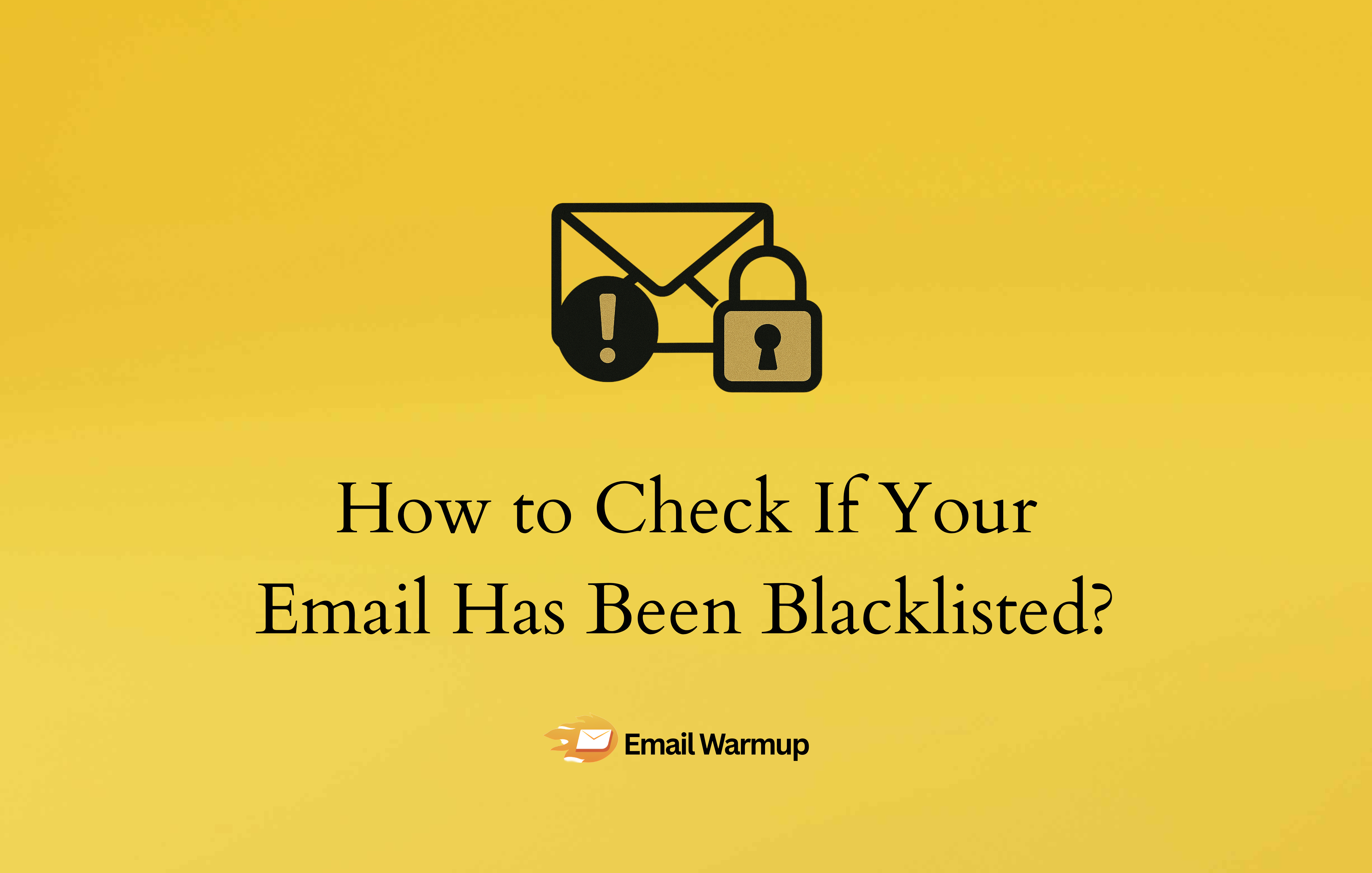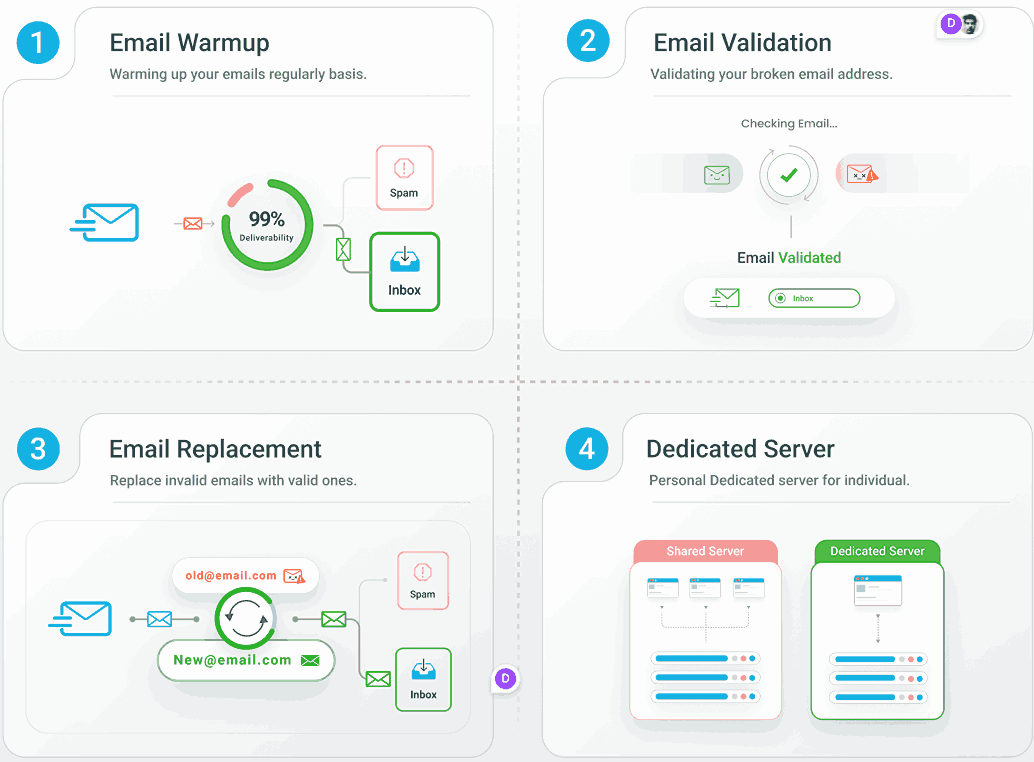
Your sales team sends hundreds of emails daily, but prospects have gone silent. Open rates dropped from 30% to 5% overnight, and your VP of Sales wants answers (yesterday).
You’re likely facing every sales leader’s nightmare — email blacklisting. When your domain hits a blacklist, outreach campaigns vanish into digital oblivion. Revenue slips away while confused teams scramble for solutions.
As an email deliverability consultant who has helped hundreds of businesses recover from blacklisting disasters (and prevented countless others), I’ve prepared this comprehensive guide that covers:
- Warning signs that indicate your emails are blacklisted
- Monitoring techniques using email metrics and ISP tools
- Immediate action steps if you discover you’re blacklisted
- How to interpret bounce-back messages and error codes
- Simple methods to check your blacklist status across major databases
Let’s show you how to diagnose blacklist issues and get your emails back in the inbox where they belong.
Quick reference — blacklist checking methods
Don’t have the time to read the entire piece? No worries. Here’s a quick skim:
| Method | What it checks | Speed | Best for |
| Email metrics Monitoring | Open rates, bounce rates, spam complaints | Instant | Early warning signs |
| Bounce-back Analysis | Error codes in failed delivery messages | Immediate | Specific blacklist identification |
| ISP Postmaster Tools | Reputation with specific providers | Real-time | Gmail, Outlook, Yahoo insights |
| Test email campaigns | Actual inbox placement | Minutes | Real-world deliverability testing |
| Automated monitoring | Continuous blacklist scanning | 24/7 | Prevention and alerts |
Let us handle the technical complexity for you
Now, you could spend hours manually checking dozens of blacklist databases, interpreting cryptic error codes, and trying to piece together why your emails aren’t delivering. Or let our deliverability experts handle the detective work while you focus on closing deals.

EmailWarmup.com offers comprehensive email blacklist monitoring and resolution:
- ISP postmaster tool integration and monitoring
- Professional delisting assistance and reputation repair
- Automated alerts when your domain or IP gets flagged
- Real-time blacklist scanning across 100+ major databases
- Expert analysis of bounce-back messages and error codes
- Ongoing email warmup services to prevent future blacklisting
We can diagnose your current situation and implement monitoring within 24 hours. Ready to get your emails back in the inbox?
Schedule your free consultation call
What does it mean when your email is blacklisted?
Email blacklists track IP addresses, domains, and email servers suspected of sending spam or malicious content.
When your sending infrastructure gets added to one of these databases, email providers use that information to block or filter your messages (often without telling you).
Major email providers like Gmail, Outlook, and Yahoo consult multiple blacklists when deciding whether to deliver your emails. Being blacklisted creates cascading problems:
- Automatic routing to spam folders
- Severe throttling of your sending reputation
- Cascading effects across other email providers
- Complete email blocking where messages never reach recipients
One week of email downtime for a 20-person sales team costs over $50,000 in lost pipeline (plus the scrambling to figure out what went wrong). Blacklisting happens fast, too.
A spike in bounces, a few spam complaints, or even a compromised email account can trigger automatic blacklist entries within hours.
How do you know if your emails are blacklisted?
Blacklisting rarely announces itself with flashing red lights. Instead, you’ll notice a pattern of declining email performance that might initially seem like normal market fluctuations.
Warning signs in your email metrics
Your email analytics reveal problems before they become disasters. Sharp performance drops indicate something changed in how email providers view your messages (and it’s rarely good news).
- Delivery delays increase noticeably across campaigns
- Open rates plummet from 25-30% to single digits overnight
- Click-through rates drop despite unchanged content quality
- Bounce rates spike above 5% (especially hard bounces that never recover)
- Spam complaint rates exceed 0.1% (1 complaint per 1,000 emails sent red flags)
- Specific domains stop engaging entirely (all Gmail or Outlook addresses go silent)
Bounce-back message analysis
Bounce-back messages contain diagnostic gold if you know how to read them. Look for specific keywords like “blocked,” “blacklist,” “spam,” or “reputation” buried in technical language that most people ignore (but you shouldn’t).
Gmail provides detailed error codes. “421” errors mean temporary blocks where emails get delayed but are not permanently rejected. “550” errors signal permanent failures requiring immediate action before Gmail accepts your emails again.
Some bounce messages explicitly name the blacklist blocking you. Messages stating “blocked due to abuse” or “blacklisted at [database name]” give you exact targets for your delisting efforts.
Monitoring through ISP tools
Major email providers offer direct insight into how they view your sending reputation. Google Postmaster Tools shows your domain’s standing with Gmail users, while Microsoft SNDS reveals your reputation with Outlook addresses.
Google’s tool categorizes your reputation as high, medium, or low (declining scores often precede blacklisting). Microsoft provides similar insights plus delivery error details. Yahoo offers feedback loops for spam complaints.
However, manually checking these tools daily becomes overwhelming fast. EmailWarmup.com integrates directly with all major ISP tools, monitoring your reputation across providers and alerting you to changes before they impact campaigns.
How can you check if your domain or IP is blacklisted?
Checking your blacklist status requires a systematic approach across multiple databases and monitoring methods. Each technique provides different pieces of the puzzle.
Manual blacklist database checking
Checking individual databases like Spamhaus and Barracuda works, but demands hours of manual effort. You’ll query dozens of databases separately while results change throughout the day (making static checks unreliable).
Free tools often scan limited blacklists, potentially missing critical entries that block your emails. Coverage gaps leave you blind to reputation problems affecting specific providers or regions.
Email performance monitoring
Your email metrics provide real-time feedback about email deliverability problems. Performance patterns reveal blacklist issues long before bounce messages arrive (giving you precious time to respond).
| Metric | Normal range | Blacklist warning | Action needed |
| Open rate | 20-35% | Below 10% | Immediate investigation |
| Bounce rate | Under 2% | Above 5% | Check sender reputation |
| Spam complaints | Under 0.1% | Above 0.3% | Review content and lists |
| Delivery time | Under 5 minutes | Over 30 minutes | ISP throttling likely |
Watch for sharp declines concentrated among specific email providers. Gmail addresses suddenly going dark while Yahoo engagement remains normal points directly to Gmail-specific email reputation issues.
Test email campaigns
Sending test emails to seed lists provides concrete evidence of inbox placement. Real-world testing reveals exactly how email providers handle your messages (theoretical checks can’t match actual delivery results).
Create test campaigns using normal content and the sending infrastructure. Monitor delivery timing and folder placement across major providers.
Emails taking unusually long to deliver or consistently landing in spam indicate reputation problems that manual blacklist checks might miss.
Professional monitoring services
Automated monitoring tracks your reputation across hundreds of blacklists simultaneously. Unlike manual checking, automated systems catch blacklist entries within minutes and monitor continuously (because blacklists change throughout the day).
Professional services interpret results in a business context rather than simply reporting technical data. You learn which listings actually impact delivery and how to prioritize response efforts accordingly.
Manual monitoring becomes impossible at scale. EmailWarmup.com scans 200+ blacklist databases continuously, sends instant alerts when issues arise, and provides expert analysis of which blacklists matter for your specific audience.
What should you do if you discover you’re blacklisted?
Discovering blacklist entries requires immediate action. The longer you remain listed, the more damage occurs to your sender reputation and business operations.
Immediate damage assessment
Start by identifying which specific blacklists flagged your domain or IP address. Different blacklists carry different weight with email providers (a Spamhaus listing impacts deliverability far more than an obscure database entry).
Determine the scope next. Check whether your domain, sending IP, or both are affected. Investigate timing, too, because recent listings might resolve quickly, while older entries often require extensive remediation.
Document the business impact immediately. Calculate lost email volume, missed opportunities, and revenue implications (clear metrics help justify the resources needed for resolution and prevent future occurrences).
Root cause identification
Blacklist entries don’t happen randomly. Common triggers create patterns you can identify and prevent (understanding the cause helps fix the problem faster).
Review recent email activities for potential causes of your email getting blacklisted.
- Change sending frequency?
- Launch a new campaign type?
- Did you import a new email list?
Most blacklist entries correlate with specific changes in sending behavior.
Technical issues trigger blacklisting, too:
- Shared IP address problems from other users
- Server security breaches are allowing spam relay
- Sudden volume spikes that alarm automated systems
- Misconfigured email authentication (SPF, DKIM, DMARC records)
Delisting process
Most blacklists provide delisting procedures, though requirements vary significantly.
Some automatically remove listings after good behavior periods, while others demand manual delisting requests with detailed explanations (knowing which type you’re dealing with saves time).
Prepare comprehensive delisting requests that address the root cause and document corrective actions. Generic or incomplete requests often get rejected, extending your blacklist duration unnecessarily.
Monitor delisting progress carefully. Some blacklists provide status updates while others remove listings silently. Continue checking your blacklist status daily until you confirm removal (persistence pays off here).
Email blacklist removal is possible, but patience and expertise is the key.
Reputation rebuilding
Delisting marks only the first step. Your sender reputation with email providers requires active rebuilding through consistent good sending practices (reputation recovery takes patience and discipline).
Gradually increase email volume while maintaining excellent metrics. Send only to your most engaged subscribers initially, then slowly expand your audience as your reputation improves. High engagement rates signal to email providers that recipients want your emails.
Implement stringent monitoring during recovery. Any setbacks during reputation rebuilding can trigger immediate re-blacklisting, often with more severe consequences than the original listing (prevention becomes even more critical after you’ve been burned once).
Your emails are too important to leave blacklist monitoring to chance

EmailWarmup.com eliminates the guesswork and manual effort from blacklist management:
- ISP postmaster tool integration for complete deliverability visibility
- 24/7 monitoring that catches issues before they impact your campaigns
- Comprehensive reputation repair and email warmup to prevent re-listing
- Professional delisting services with direct blacklist provider relationships
- Continuous monitoring across 200+ blacklist databases with instant alerts
- Expert analysis and interpretation of all blacklist entries and their business impact
Our clients typically see full blacklist resolution within 72 hours, compared to weeks of DIY troubleshooting. More importantly, our monitoring prevents most blacklist issues from occurring in the first place.
Stop letting blacklist uncertainty sabotage your email campaigns — let our experts ensure your emails reach the inbox every time.



